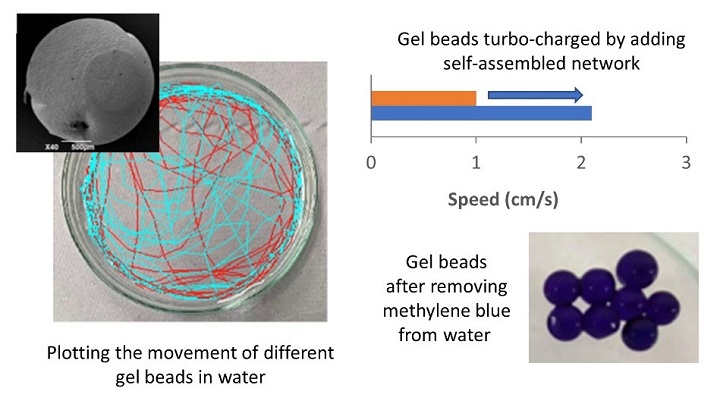Self-Propelling Gel Beads as Highly-Mobile Waste Collectors
Recent research from the Department of Chemistry has created gel beads that can spontaneously move when placed in water. By assembling a unique nanoscale network within the particles, the beads become turbo-charged and better able to remove a pollutant dye from the water.

Working in the research lab of Professor David K. Smith, Dr Carmen Piras fabricated innovative hybrid gel beads by mixing the well-known polymer gelator agarose with a self-assembling small molecule gelator previously developed in their lab. After soaking the hybrid gel beads in ethanol and placing them in water, she found that they spontaneously moved around in the water, as can be seen in this video.
This type of movement is actually well-known, and occurs as a result of the so-called ‘Marangoni Effect’ - as the ethanol diffuses out of the beads it changes the surface tension of the water. However, what surprised the researchers, was that by incorporating their own self-assembled network within the agarose beads, they could turbo charge the movement, enabling the beads to move twice as fast, and twice as far, in the first minute.
By cutting the gels into different shapes, they could control the type of movement. For example, by cutting the gel into a star-shape, it tended to spin on its own axis, rather than moving through the water like the spherical beads.
The researchers knew that their self-assembled network should be capable of binding to pollutants, like the industrial dye, methylene blue. Fascinatingly, these properties were transferred to the moving gel beads, which became much better able to remove this pollutant from water.
Dr Piras said: “We hope that in the future, self-propelling gel beads such as these may be able to remove pollution from difficult to reach areas – essentially seeking it out and collecting it like a mobile waste collector. To achieve this we would need to achieve greater control over the movement of the gel beads, and optimize the self-assembled network to maximise pollutant uptake.’
The research is published Open Access in Chemistry – A European Journal.